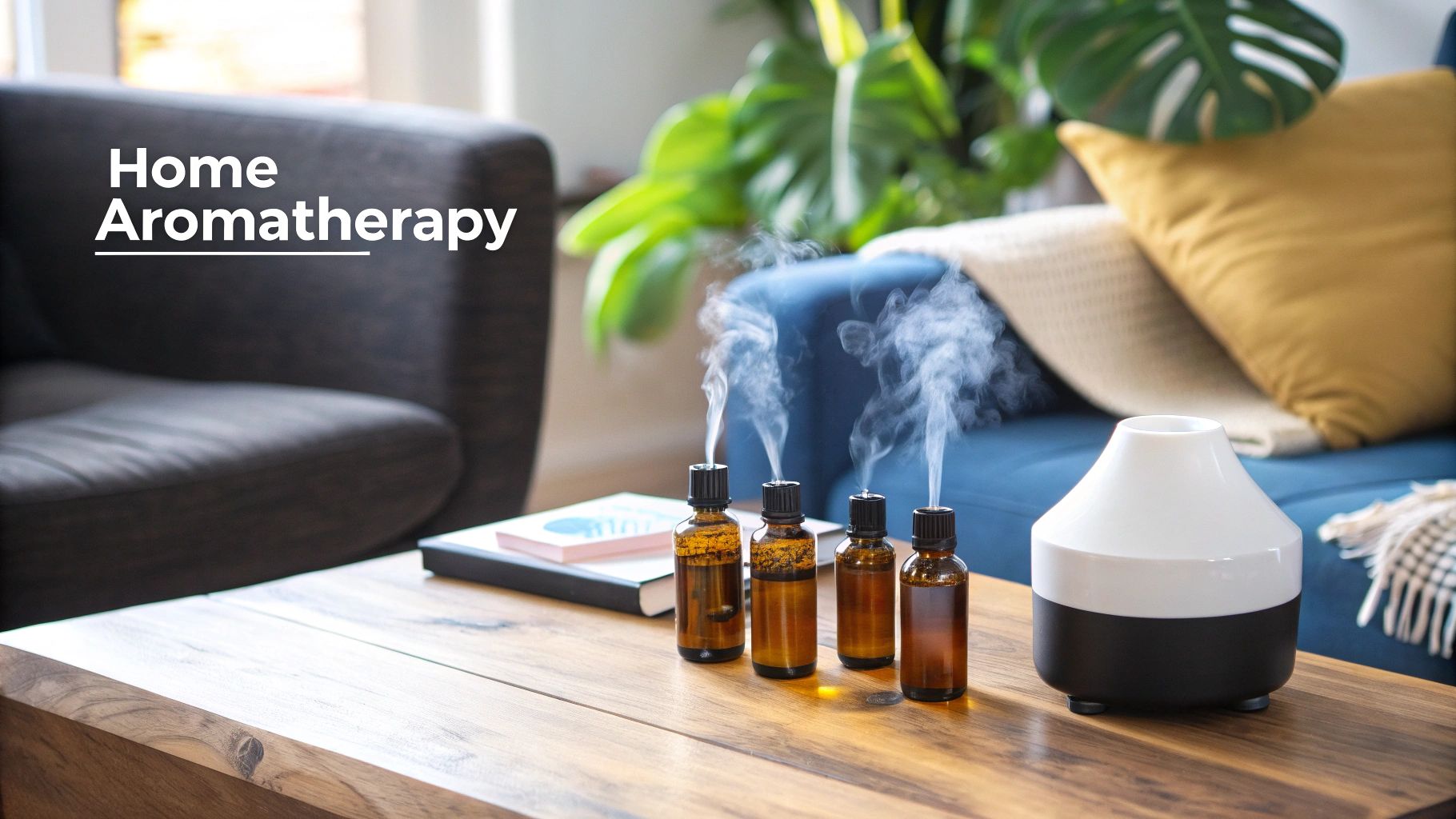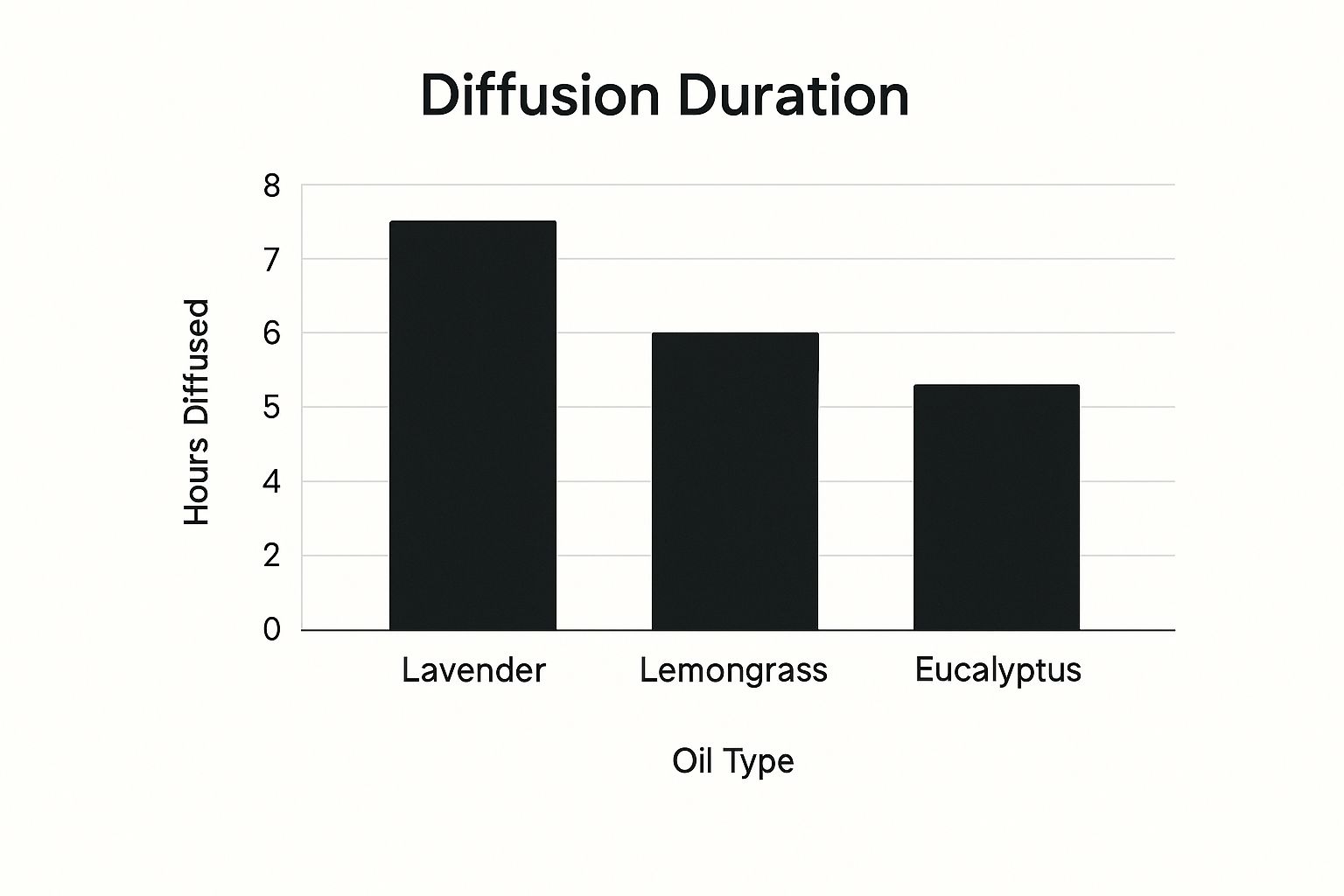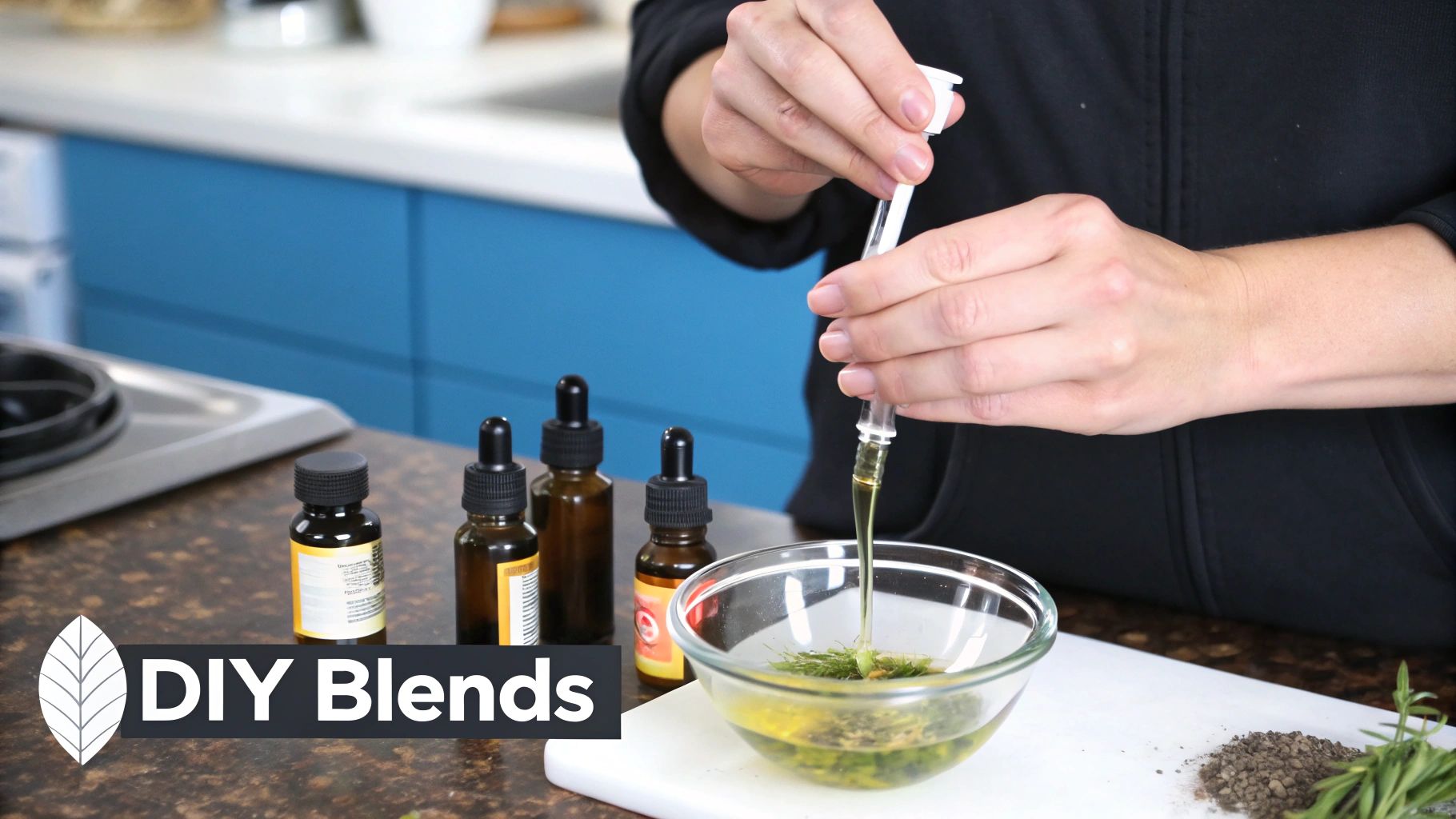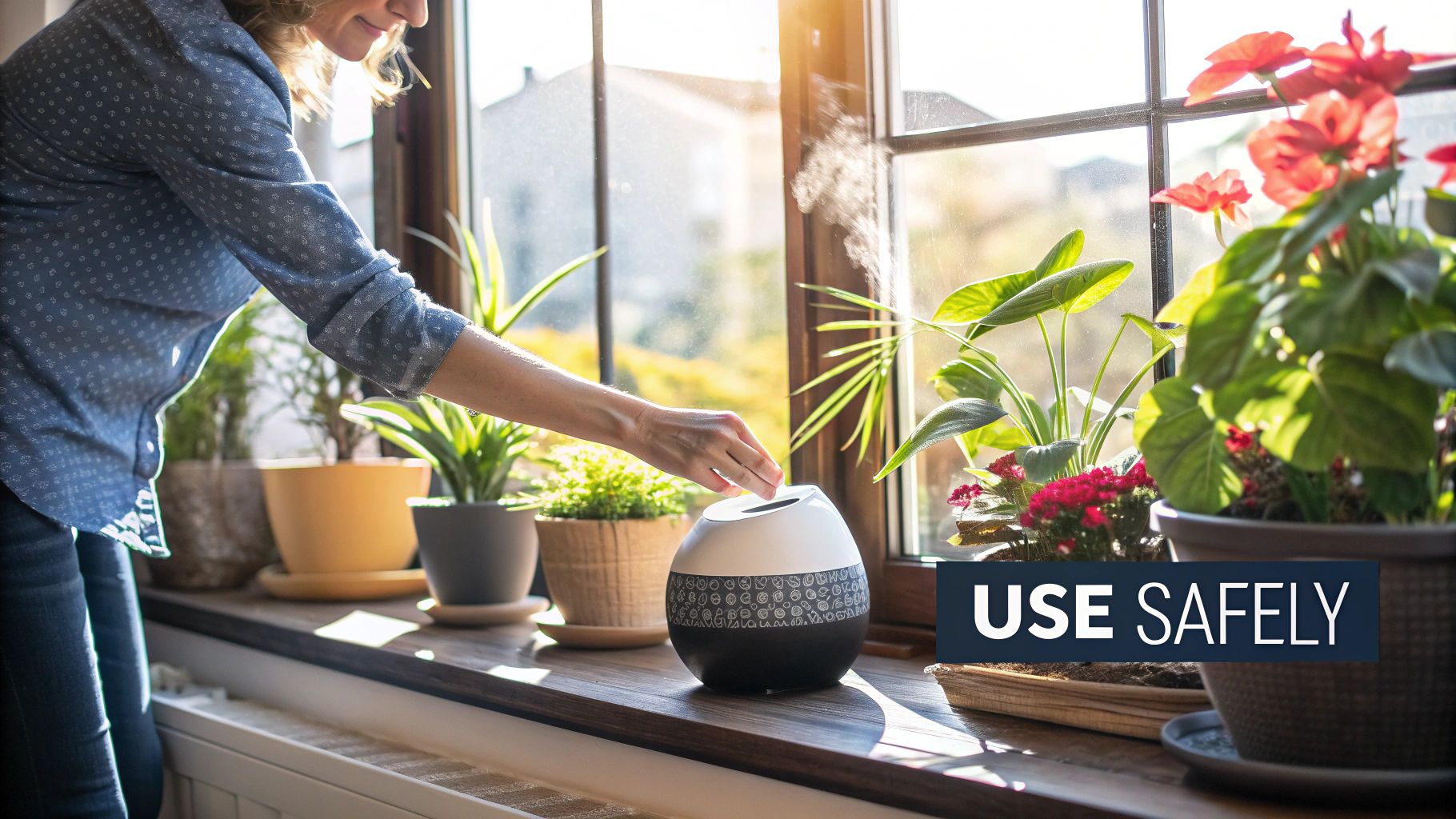A Guide to Home Fragrance Essential Oils
Aug 17, 2025
If you're looking for the best way to create a natural, inviting, and genuinely healthy atmosphere in your home, look no further than home fragrance essential oils. Unlike synthetic air fresheners that just cover up smells, pure essential oils deliver authentic aromas straight from the plant, completely changing your home's vibe while offering real wellness benefits.
Transform Your Home with Natural Scents
Imagine walking through your front door into a personal sanctuary, where the air feels fresh, clean, and is subtly layered with a beautiful, natural scent. This guide is all about helping you ditch the harsh chemical sprays and embrace the gentle, holistic power of essential oils for your home.
These potent plant extracts are so much more than a pretty smell. They can genuinely lift your mood, help melt away stress, and create an atmosphere that feels truly welcoming. A thoughtfully chosen scent can turn any room into a personal retreat, making every moment you spend inside that much more enjoyable.

Why Choose Natural Fragrances
The move toward natural living isn't just a fleeting trend—it's a conscious choice for a healthier life, and what you scent your home with is a huge part of that. People are paying more attention than ever to the ingredients in their household products, which has led to a massive surge in the popularity of essential oils.
This growing preference for all things natural and organic is driving some serious market growth. The global essential oils market was recently valued at around USD 25.86 billion and is only expected to keep climbing. You can dig into the numbers yourself and learn more about the essential oils market growth on grandviewresearch.com.
What this all comes down to is a deeper understanding that what we breathe in is just as important as what we eat. When you choose pure essential oils, you're opting for a solution that's completely free from the parabens, phthalates, and other synthetic junk often found in conventional air fresheners.
A Guide to Aromatic Living
In this guide, we'll walk you through everything you need to know. We'll start with the science behind the scents and get you all the way to mastering the art of diffusion with premium tools like Airomatica diffusers.
Here’s a little peek at what you'll learn:
- Understand the Science: We'll break down how different aromas interact with your brain to influence your mood and even trigger memories.
- Select the Perfect Scent: You'll get the hang of finding just the right oils to create the specific atmosphere you want in each room.
- Master Diffusion: Discover the best practices for using your diffuser to get a consistent, beautiful, and lasting fragrance.
Our goal is simple: to help you turn your home into a place that doesn't just smell good, but feels incredible.
What Are Essential Oils and How Do They Work?
Let's clear the air and talk about what home fragrance essential oils really are. These aren't just pretty perfumes. Think of them as the very essence of a plant—its life force, concentrated and captured in a bottle.
These powerful, volatile aromatic compounds are pulled directly from the leaves, flowers, bark, or roots of a plant. It’s all done through careful methods like distillation or cold pressing, which ensures what you get is pure.
To put it in perspective, a single drop of peppermint oil packs the punch of about 28 cups of peppermint tea. That incredible concentration is what makes them so potent. We're not talking about synthetic fragrances whipped up in a lab; this is the unadulterated scent and soul of the plant itself.
So, when you diffuse these oils, their microscopic particles float through the air and you breathe them in. This is where the real magic happens, creating a direct pathway straight to your brain.
The Science of Scent and Mood
That connection you feel between a certain smell and a powerful emotion? It's not just in your head—it's hardwired into your biology.
When you inhale an essential oil, those tiny aroma molecules travel up your nose to the olfactory bulb. This little hub has a direct line to the limbic system in your brain.
The limbic system is often called the "emotional brain." It's the command center for your emotions, memories, and even your gut reactions. This is precisely why a whiff of a specific scent can instantly zap you back to a childhood memory or wrap you in a blanket of calm.
This direct link is the reason aromatherapy can have such a profound and immediate effect on your mood. For example:
- Lavender: Its calming compounds are known to interact with neurotransmitters, helping to dial down anxious feelings and encourage relaxation.
- Lemon: This bright, zesty oil is famous for boosting mood and sharpening focus, making it perfect when you need to create an uplifting, energizing vibe.
- Eucalyptus: That strong, clean aroma works wonders to open up airways and promote a feeling of clear, easy breathing.
More Than Just a Pretty Smell
Beyond just making you feel good, many essential oils have natural properties that can actively improve your home’s environment.
Some oils have demonstrated antibacterial and antiviral qualities, helping to cleanse the air you and your family breathe. This gives them a powerful one-two punch for your home: they create a beautiful sensory experience and contribute to a healthier living space.
This growing appreciation for natural wellness has kicked off a massive shift in how people care for their homes. The market for essential oils just keeps expanding as more of us look for organic and eco-friendly solutions. In fact, Europe is leading the charge, holding a market share of more than 49.4%. You can dive deeper into the global essential oils market trends on imarcgroup.com.
Understanding their power is the first step in completely transforming your home's atmosphere.
Choosing The Right Oils For Every Room
Think of yourself as the "scent architect" of your home. It’s a fun journey, and honestly, it’s pretty rewarding. Each room in your house has a job to do, a different feeling, and the right aroma can completely elevate that space. Choosing the perfect oil isn’t about following strict rules; it's about listening to your intuition and matching a scent’s natural properties to the atmosphere you want to create.
Take your entryway or kitchen, for example. These are high-energy, bustling spaces. You need something bright and uplifting, which is where citrus oils like lemon, orange, or grapefruit are absolute heroes. Their zesty, clean fragrance cuts through lingering food smells and instantly creates a welcoming, vibrant vibe for anyone who walks in.
But for a space where you want to relax or focus, like a home office or living room, you’ll want to take a completely different approach. These areas really benefit from grounding, earthy scents that encourage a sense of calm and concentration.
Creating Specific Moods Room by Room
To get this right, think about the main activity in each room. Are you trying to feel energized? Relaxed? Focused? The right essential oil is your secret weapon for setting that specific tone.
For a productive home office, grounding scents like sandalwood or cedarwood are fantastic. These rich, woody aromas are known for helping to sharpen focus and cut through mental clutter, making it easier to get into that deep work zone. A little rosemary in the mix can also give you a nice boost in alertness and memory.
When it’s time to unwind in the living room, you want something rich and comforting. Oils like frankincense, patchouli, or even a warm vanilla blend can create a cozy, inviting atmosphere that’s perfect for relaxing with family or curling up with a good book.
Your home's fragrance is an invisible layer of decor. Just as you choose colors and textures to create a visual mood, you can select specific essential oils to build an emotional atmosphere in every single room.
Designing a Restful Bedroom Sanctuary
If there’s one room you really want to get right, it’s the bedroom. This is your sanctuary for rest and rejuvenation, so calming, soothing aromas are a must. This is where gentle florals and soft herbs really get to shine.
Lavender is the classic for a reason—its calming properties are well-documented and work wonders for easing the mind before sleep. Chamomile is another beautiful choice, with its soft, almost apple-like scent that promotes deep tranquility. You can even blend these with a hint of ylang-ylang for a touch of sweetness, turning your bedroom into a true retreat.
To learn more about crafting the perfect atmosphere, you might want to check out our guide on the 7 best essential oils for home scent.
The longevity of a scent is also worth considering. This chart gives you an idea of how long you can expect different aromas to last.

As you can see, oils like lavender tend to stick around longer, making them a great choice for all-night diffusion, while others might need a refresh.
To make things even easier, I've put together a quick guide to help you match the right oil to the right room.
Essential Oil Scent Profile and Room Guide
| Essential Oil | Scent Profile | Primary Benefit | Best For (Room) |
|---|---|---|---|
| Lavender | Floral, herbaceous, soft | Calming & Sleep-Promoting | Bedroom, Nursery |
| Lemon | Citrus, fresh, zesty | Energizing & Purifying | Kitchen, Bathroom |
| Peppermint | Minty, sharp, cool | Focus & Alertness | Home Office, Gym |
| Sandalwood | Woody, rich, earthy | Grounding & Meditative | Living Room, Study |
| Eucalyptus | Camphorous, airy, clean | Decongestant & Refreshing | Bathroom, Entryway |
| Chamomile | Sweet, herbal, apple-like | Relaxing & Soothing | Bedroom, Reading Nook |
This table is just a starting point, of course. The best part about using essential oils is experimenting to find the scents that feel right for you and your home.
Mastering the Art of Home Diffusion
Getting the most out of your home fragrance essential oils isn't just about picking a scent you love—it’s about how you share that aroma throughout your space. The diffuser you choose has a huge impact on the scent’s purity, its strength, and even its therapeutic qualities.
Think about it: many common diffusers, like the ultrasonic or heat-based models you see everywhere, can actually change the very structure of the essential oils. Ultrasonic diffusers need water, which dilutes the oil’s true power. Heat-based models can break down the delicate aromatic compounds, which not only weakens the fragrance but also strips away its wellness benefits.

Why Cold-Air Nebulizing Is a Game-Changer
If you're after a truly authentic and powerful aromatic experience, cold-air nebulizing technology is in a league of its own. This is the method we use in our high-end Airomatica diffusers, and it works without a single drop of water or any heat. Instead, it uses filtered air to break down pure essential oil into an ultra-fine, dry mist of nanoparticles.
This process keeps the oil's integrity perfectly intact. And because these micro-particles are so incredibly light, they hang in the air for much, much longer. The result is a consistent, beautiful scent that fills your entire home. If you want to dive deeper into the science, you can find out more about how an oil diffuser works in our dedicated guide.
Nebulizing diffusers deliver the purest form of aromatherapy. By keeping the oil's molecular structure intact, you get the full, unadulterated fragrance profile and its complete therapeutic benefits, just as nature intended.
It’s no surprise that as more people focus on wellness, they're turning to natural and organic products—and aromatherapy diffusers are a huge part of that shift. It shows a real desire for home fragrance solutions that don't just smell good but actually contribute to a healthier, more authentic lifestyle.
Your Step-by-Step Guide to Effective Diffusion
Ready to use your diffuser like a pro? Following a few simple but critical steps will ensure you get the best possible results while making your device last.
- Always Use High-Quality Oils: This is the foundation. Start with 100% pure essential oils. Synthetic fragrance oils can contain chemicals that are not only potentially harmful but can also damage the delicate internal parts of your diffuser over time.
- Follow the Quantity Guidelines: More isn't always better. Add the recommended amount of oil to your device—with powerful nebulizing diffusers, a little goes a very long way. Overfilling can be wasteful and less effective.
- Optimize Your Run Times: For a consistent ambiance, it’s actually better to run your diffuser in intervals rather than leaving it on continuously. Many advanced models, including those from Airomatica, come with programmable timers that let you customize the scent intensity and operating hours to fit your life.
- Keep It Clean: This is non-negotiable for peak performance. At least once a month, give the reservoir a quick wipe-down with a soft cloth and a bit of rubbing alcohol. This removes any lingering oil residue and ensures every diffusion is as pure and clean as the first.
Crafting Your Signature Scent Blends
Ready to play scent artist and mix up your own signature aromas? Blending home fragrance essential oils is where the real fun begins. It's a creative process that lets you design a fragrance that makes your space feel completely, uniquely yours. It’s a lot simpler than you might think, and it unlocks a whole new world of aromatic possibilities.

The secret to a great blend isn't just mixing scents you like; it's about understanding fragrance notes. Just like building a musical chord, a well-rounded scent combines different notes to create something harmonious and complete—an aroma that actually evolves over time.
Think of it this way: top notes are the bright, initial melody; middle notes are the heart of the song; and base notes provide the deep, lasting rhythm that holds everything together.
Understanding Fragrance Notes
A balanced blend almost always includes oils from all three categories. This structure is what gives your custom fragrance its complexity and staying power, ensuring it doesn't just fade away after a few minutes in your diffuser.
- Top Notes: These are the first scents that hit your nose. They’re light, often fresh, and they evaporate quickly. Think of zesty citrus like Lemon and Orange or crisp herbs like Peppermint.
- Middle Notes: This is the heart of the fragrance. These notes start to shine just as the top notes fade away. They are usually floral or herbaceous—think Lavender, Chamomile, and Rosemary.
- Base Notes: These are the deep, rich aromas that ground the blend and linger the longest. Woody and resinous oils like Sandalwood, Cedarwood, and Frankincense are classic base notes.
Simple Blending Recipes to Get You Started
Honestly, experimenting is the best way to discover what you really love. But to get you started, here are a few simple recipes designed for different moods. Just add these drops directly to your diffuser.
1. Relaxing Evening Blend
This combination is absolutely perfect for unwinding after a long day. It creates a deeply tranquil and serene atmosphere for a living room or bedroom.
- 4 drops Lavender (Middle)
- 3 drops Sandalwood (Base)
- 2 drops Orange (Top)
2. Fresh & Clean Blend
Ideal for kitchens or entryways, this blend clears the air and leaves behind a bright, welcoming scent that feels instantly invigorating.
- 4 drops Lemon (Top)
- 3 drops Eucalyptus (Top/Middle)
- 2 drops Peppermint (Top)
3. Cozy Fireside Blend
Want to create a warm, comforting vibe? This rich, grounding mix is your go-to. It’s perfect for a relaxing night in.
- 4 drops Sandalwood (Base)
- 2 drops Cinnamon (Middle)
- 1 drop Patchouli (Base)
Essential Oil Safety in Your Home
Embracing home fragrance essential oils is a wonderful way to elevate your living space, but their natural potency calls for a bit of respect. Think of them like any powerful ingredient in your kitchen—using them correctly is the key to a safe and amazing experience for everyone under your roof. A few simple guidelines are all you need to enjoy their benefits without a single worry.
One of the golden rules is that essential oils should almost never be used undiluted on the skin, and they should absolutely never be ingested. When you're diffusing them, they're generally very safe, but good ventilation is crucial, especially in smaller rooms. You want the fragrance to breathe and mingle with the air, not completely take over the space.
Special Considerations for Your Household
Every home has its own unique mix of people and pets, and being mindful of them is a huge part of using essential oils safely. The simple truth is that children and animals are much more sensitive to the powerful compounds in these oils, so a little extra care goes a long way.
For example, our furry friends have a sense of smell that's worlds beyond ours. A scent that's pleasant to you could be overwhelming or even irritating to them.
Always make sure your pets have an easy way to leave a room where an oil is being diffused. This simple step gives them the power to move somewhere else if they find a scent too strong for their liking.
Pet Safety Guidelines
When it comes to essential oils and pets, caution is your best friend. Some oils are known to be toxic to cats and dogs if they lick them, get them on their fur, or even inhale them in high concentrations.
- Oils to Avoid Around Pets: Be extra careful with oils like Tea Tree, Pennyroyal, Pine, Wintergreen, Cinnamon, and certain citrus oils.
- Safe Diffusion Practices: Always run your diffuser in a large, well-ventilated area. It's also best to run it for limited periods, like 30 minutes on, then 30 minutes off.
- Monitor Your Pet: Keep an eye out for any signs of discomfort—things like drooling, squinting, whining, or sudden changes in behavior. If you spot anything unusual, switch off the diffuser immediately and get your pet into fresh air.
Child-Friendly Oil Usage
Little ones, especially infants and toddlers, have much more sensitive systems. Their skin is thinner and their bodies are smaller, which makes them more reactive to the strong effects of essential oils.
- Heavily Dilute: If you are ever applying an oil topically (and you should always consult a professional first), heavy dilution isn't just a suggestion—it's a must.
- Kid-Safe Choices: Stick with gentle, calming oils like Lavender, Chamomile, and Sandalwood.
- Avoid Strong Oils: Steer clear of diffusing potent oils like Peppermint and Eucalyptus around very young children. They contain high levels of menthol and cineole, which can be too intense for their developing respiratory systems.
By keeping these straightforward safety tips in mind, you can confidently make the art of home fragrance a beautiful part of your daily life. For more inspiration on creating an inviting and lasting aromatic atmosphere, take a look at our guide on the 12 best long-lasting home fragrances.
Common Questions About Home Fragrance Oils
When you first start exploring the world of home fragrance essential oils, it's natural to have a few questions. Getting a handle on the practical side of things helps you get the most out of your aromatherapy journey, making sure every single drop adds to that beautiful, welcoming atmosphere you're creating. Let's get into some of the most common queries we hear.
How Long Does The Scent Last?
The truth is, how long a scent sticks around depends on a few things: the type of diffuser you're using, how big the room is, the airflow, and of course, the oils themselves. A powerful nebulizing diffuser can fill a space in minutes, and you'll still notice the scent lingering for 1-2 hours after it’s turned off.
You'll also find that lighter, zesty top notes, like citrus oils, tend to fade a bit faster. On the other hand, those deep, heavy base notes like sandalwood and cedarwood have a rich aroma that has some serious staying power.
Are Pure Essential Oils Expensive?
It’s true that a bottle of high-quality essential oil costs more upfront than a synthetic air freshener, but it's incredibly concentrated. You only need a few drops for each session, which means a single bottle can last a surprisingly long time.
When you think about their potency, longevity, and the real wellness benefits they bring, pure essential oils are a much more cost-effective and healthier way to fragrance your home in the long run.
Can I Use Any Oil In My Diffuser?
For the best experience—and to keep your device happy—you should always stick with 100% pure, therapeutic-grade essential oils. It's best to avoid those synthetic "fragrance oils." They don't offer any real benefits, and their chemical makeup can actually damage the delicate internal parts of your diffuser over time.
Also, keep in mind that very thick, resinous oils might not work well in every device. It's always a smart move to check your diffuser's manual for any specific advice or restrictions.
Ready to transform your home with luxurious, long-lasting aromas? Discover the power of pure fragrance with Airomatica and find the perfect scent solution for your space. https://airomatica.com



